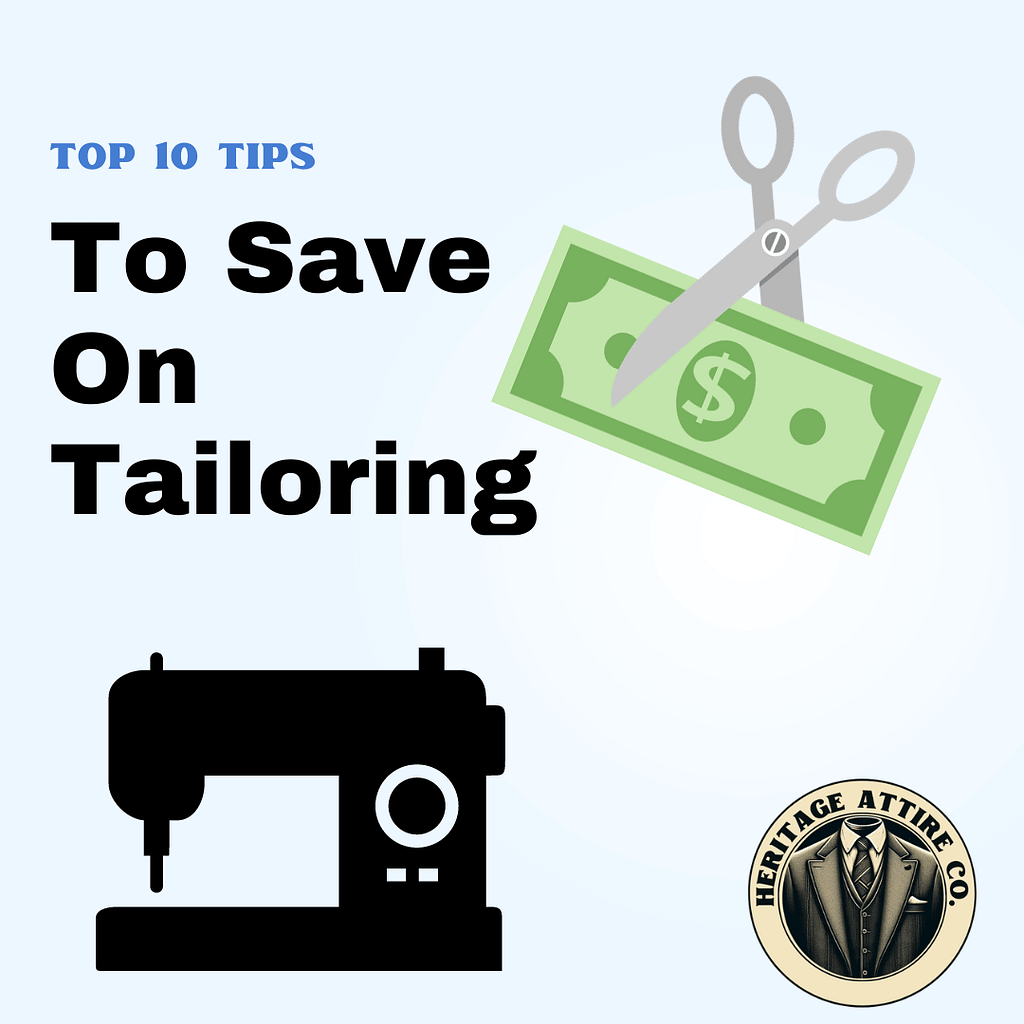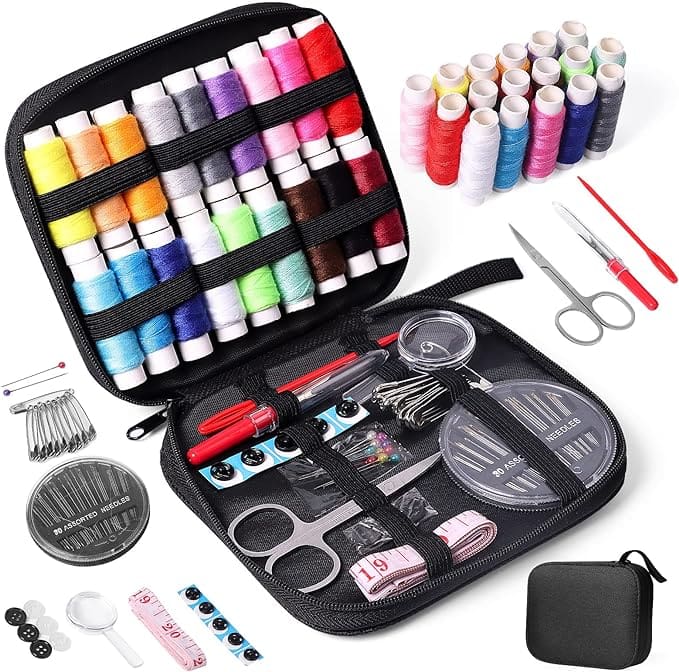Tailoring is an essential aspect of a well-dressed individual’s wardrobe. However, it can also be a significant expense. Here are detailed strategies to save on tailoring without sacrificing style or fit:

Table of Contents
1. Buy Clothes That Need Minimal Alterations
When shopping for new clothes, the key to saving on tailoring is to choose garments that require the least amount of alteration. Focus on finding items that fit well in crucial areas such as the shoulders for jackets, and the waist for trousers. These areas are often the most difficult and expensive to alter. For instance, a jacket that fits well in the shoulders but needs minor adjustments at the waist or sleeve length is more economical to tailor than one that requires a complete overhaul. This approach not only reduces tailoring costs but also ensures the integrity of the garment’s original design is maintained.
When trying on clothes, pay close attention to how they fit in these critical areas. The right fit in the shoulders, chest, and hips is essential for a polished look. Garments that fit well in these areas will typically only require minor, less costly adjustments like hemming trousers or taking in a waistband. Remember, while many aspects of a garment can be altered, some, like shoulder width and jacket length, are challenging to change without significant expense.
2. Shop During Sales or Discount Periods
Purchasing clothing during sales or discount periods can lead to significant savings, both on the garments themselves and potentially on their alterations. Many stores offer seasonal sales, clearance events, and special promotions where you can find high-quality items at reduced prices. This is particularly true for high-end brands, where the markdowns can be substantial. However, it’s important to remain selective and focus on fit and quality, even when shopping sales.
Another benefit of buying during sales is that alterations on discounted items might also be less expensive. Some tailors offer promotions in tandem with retail sales periods, knowing that customers are likely to buy new clothes that may need adjustments. Keep an eye out for these opportunities and plan your shopping accordingly. Remember, the goal is to buy smart – looking for deals on quality pieces that fit well and will stand the test of time.
3. Choose Classic Styles and Versatile Pieces
Investing in timeless and versatile clothing items can save on tailoring in the long run. Classic styles, such as a well-tailored navy blazer or a simple sheath dress, have the advantage of longevity. They remain stylish year after year, reducing the need to frequently update your wardrobe. Additionally, these pieces often require less tailoring as they are designed with clean, simple lines that fit a variety of body types well.
Versatile pieces also offer more outfit options, allowing you to mix and match with different items in your wardrobe. This reduces the need to constantly buy new clothes to keep up with trends. For example, a classic white button-down shirt can be worn with dress pants for a formal look, or with jeans for a casual outing. By investing in such adaptable pieces, you enhance your wardrobe’s flexibility while minimizing the need for frequent and costly alterations.
4. Prioritize Quality Fabrics and Construction
Selecting garments made from high-quality materials and superior construction can significantly save on tailoring costs. Quality fabrics tend to maintain their shape and appearance over time, meaning the garment will require fewer adjustments. For example, a suit made from high-quality wool will resist wrinkles and retain its fit better than one made from a cheaper fabric blend. This resilience means less frequent trips to the tailor for reshaping or repairs.
Additionally, well-constructed clothing is easier to alter when necessary. Garments with generous seam allowances, for instance, offer more flexibility for adjustments. Pay attention to the details when shopping – look for even stitching, properly aligned patterns, and sturdy buttons and zippers. These are all indicators of a well-made garment that won’t require frequent fixes.
5. Know Basic Sewing Skills for Minor Fixes
Easy way to save on tailoring
Acquiring basic sewing skills can be a game-changer in managing tailoring costs. Simple tasks like reattaching buttons, mending small tears, or adjusting hems are easy to learn and can be done at home with just a few tools. There are numerous resources available online, from tutorials to step-by-step guides, that can teach you these basic skills. Investing a little time in learning to sew can save you both time and money in the long run.
Not every clothing issue requires professional intervention. For minor fixes, a home sewing kit – complete with needles, thread, scissors, and measuring tape – can be your best friend. Learning to do these small repairs yourself not only saves money but also extends the life of your garments. Plus, there’s a certain satisfaction in being able to handle these quick fixes on your own. Whether it’s hemming a pair of pants that are just a tad too long or fixing a loose button on a shirt, these are skills that will serve you well throughout your life. They allow for immediate solutions, ensuring your clothes are always in the best possible condition.

Sewing Kit with Case Portable Sewing Supplies
All You Need in Sewing – The kit contains all the necessary tools that are required for performing basic repairs, be it a needles, threads, scissors, buttons, threader tools, seam ripper and all sewing tools.
6. Bundle Alterations for Cost Savings
If you find yourself with multiple items needing adjustments, consider bundling these alterations together. Many tailors offer discounts for multiple items, as it’s more efficient for them to work on several pieces from the same customer at once. This strategy can lead to significant savings per garment. For example, if you have several pairs of pants that need hemming or a couple of jackets that require sleeve adjustments, bringing them to the tailor at the same time can be more cost-effective than doing them separately.
When planning a trip to the tailor, take a look through your wardrobe to see if there are other items that could also use some tweaking. Maybe a dress that could be taken in a bit for a better fit, or a coat whose buttons need reinforcing. Not only does this save money, but it also ensures that your entire wardrobe is always in top condition, ready to wear without last-minute issues.
7. Check for Free Alterations with Purchases
Some retailers, particularly those in the mid to high-end range, offer free or discounted alterations when you purchase clothing from them. This is especially common with business and formal wear. Always inquire about alteration services when buying new clothes, as this can add significant value to your purchase. For instance, some stores might offer complimentary hemming on pants or basic tailoring adjustments on suits.
When shopping for more expensive items, such as suits or formal dresses, this perk can be a deciding factor. The cost saved on tailoring can make a pricier item more worthwhile in the long run. Additionally, these stores often have skilled tailors who are familiar with the brand’s clothing, ensuring high-quality alterations that maintain the garment’s integrity.
8. Consider Secondhand or Thrifted Clothing
Thrift stores and secondhand shops can be excellent sources for high-quality clothing at a fraction of the retail price. Often, you can find gently used or even new items from reputable brands. The money saved on the purchase price can be allocated toward tailoring these finds for a perfect fit. It’s not uncommon to find designer labels or high-quality garments that, with a little tailoring, can become valued pieces in your wardrobe.
When shopping secondhand, look for garments made from durable fabrics and with timeless designs. Even if they require some alterations, the overall cost will likely still be lower than buying new. Plus, this approach is environmentally friendly, as it extends the life of clothing and reduces waste.
9. Discuss Alterations with Tailors in Detail
Effective communication with your tailor is crucial. Be clear about your budget and what alterations are essential. Discuss the options and focus on the adjustments that will have the most significant impact on the fit and look of the garment. For example, if a jacket fits well in the shoulders but is a bit loose around the waist, having the waist taken in can dramatically improve its appearance.
Also, ask the tailor for their advice on what alterations they think are necessary and what can be foregone. A good tailor can provide guidance on what changes will make the most difference, helping you prioritize based on your budget and the garment’s needs.
10. Maintain Clothing to Avoid Repairs
Regular maintenance of your clothing is key to avoiding costly repairs and alterations. Properly caring for your garments – such as adhering to washing instructions, storing them correctly, and addressing minor issues promptly – can greatly extend their lifespan. For instance, hanging suits and blazers on proper hangers maintains their shape, while gentle washing and air-drying can prevent excessive wear and shrinkage.
Additionally, be proactive in caring for your clothes. Treating stains immediately, rotating your wardrobe to avoid over-wearing certain items, and keeping moths away from woolens are all steps that ensure your garments stay in top condition. Paying attention to how you clean and store your clothes can prevent them from losing their shape, color, and texture. This means less frequent trips to the tailor for adjustments due to wear and tear.
For instance, wool suits should be brushed after each wear to remove dirt and hung on wide, padded hangers to retain their shape. Similarly, properly folding and storing knitwear can prevent stretching and distortion. These small yet consistent care routines can make a significant difference in maintaining the original fit and appearance of your clothes.
In Summary: Smart Strategies for Tailoring and Garment Care
By adopting these strategies, you can effectively manage to save on tailoring while looking sharp. It’s about making informed choices – from the point of purchase to daily garment care. Opting for clothes that fit well in key areas reduces initial alteration needs. Understanding and utilizing sales, investing in timeless styles, prioritizing quality, learning basic sewing skills, bundling alterations, taking advantage of free alteration services, exploring thrift stores, communicating effectively with tailors, and maintaining your clothing are all ways to ensure that your wardrobe not only fits well but also stands the test of time both in style and durability.
This approach to selecting, maintaining, and altering your clothes allows for a wardrobe that is not only stylish and well-fitting but also economical and sustainable in the long run. Remember, a well-cared-for garment can last years, making it a more valuable and cost-effective addition to your wardrobe than constantly replacing poorly fitting or worn-out clothes.
Did we miss any tip to save on tailoring? What would you recommend?
Read more: Mastering Tailoring: Pre and Post-Purchase Considerations for Suits and Jackets


One response to “10 Pro Tips to Save on Tailoring”